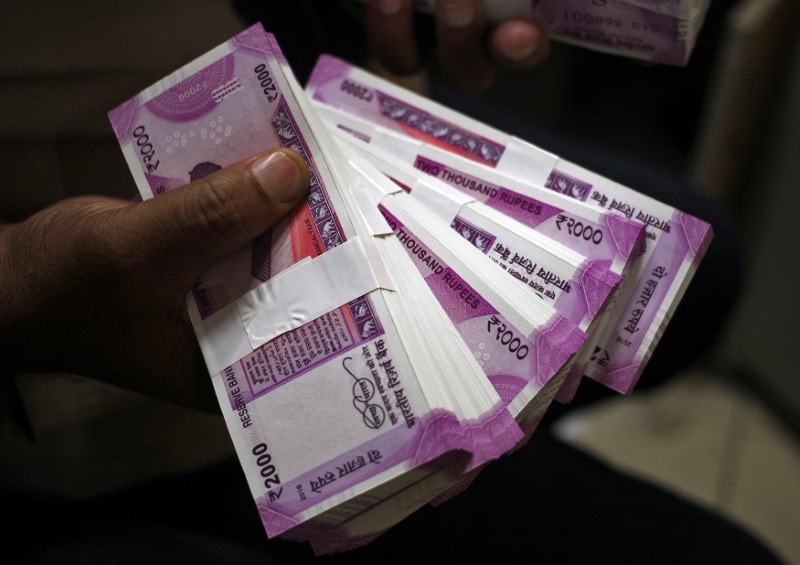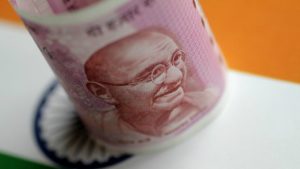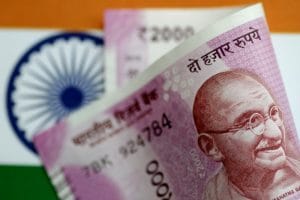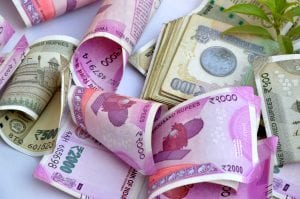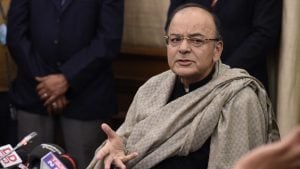The GST council met today for the 29th time. The digital payments have been incentivised and the rollout will begin on a pilot basis. A new committee has been set up to look at issues faced by small and medium enterprises.
Sapna Das caught up with the Economic Affairs Secretary S C Garg and spoke to him on a wide range of issues.
Q: Certain concerns are already been raised on the fiscal situation, now we have the numbers in public. But one or two points I will put at your step and you can take it forward which is basically certain concerns are being raised on the possible MSP impact, Ayushman Bharat impact. Also if you look at the goods and services tax (GST) numbers we are given to understand that there is still a revenue gap because you have a certain run rate in terms of achieving the target and you growing at a certain space as of now the first quarter is just over. So keeping all of this in mind of course the other question that pre-election year and expectations basically from the political economy so what is your sense are we really comfortable as of now, we are comfortable probably but a bit of concern and we will make sure that second half is accordingly taken care of once consumption picks up further?
A: I thought these concerns, which have been actually expressed not now but last 4-5 months ever since the Budget was presented are much less pronounced. The concern on MSP was far more, there was much like of understanding information at the time of Budget presentation in the media and the analyst etc. but thereafter everything has come out in the open. The government has actually adopted the principle of giving 50 percent cost plus prices. Those numbers have also come up that even if this is given what it means if you make a 50-60 percent kind of procurement.
Q: We are not very clear on those numbers?
A: You may not be but I think these numbers have become available publicly. I have also spoken about it. It is not that I have not have spoken, I have spoken about a range maximum about Rs 30,000. Starting from let us say Rs 10,000 -12,000 to Rs 30,000 crore maximum impact given if these prices still remain depressed, prices don’t go up. So also those things have been mentioned, understood.
We have also discussed earlier that the MSP as far as the fiscal impact is concerned, you make procurement for the kharif crops in October-November then those get sold much later in January-February or even later in March-April. The fiscal impact is only at a time when there is sale at a loss. So, the fiscal impact in the current year of the MSP is hardly anything material.
Q: But there will be an impact?
A: Of course, Rs 5,000-10,000 crore here and there is not a big deal for a Rs 25,00,000 crore Budget it is not very much and we have already made a provision in food subsidies, which are there.
Q: Rs 1.60 lakh for this?
A: Rs 1.6 to Rs 1.8 lakh crore getting Rs 5,000-10,000 crore here and there for that is not too drastic. On the Ayushman Bharat, things have become much clearer. They have been sharing in the media, they put out the rates which are being allowed to the agencies.
Q: Rs 24,000 crore odd is what is we given to understand.
A: No, it is certainly not even that. We have been saying, we have stated – maximum impact during the current year between Rs 6,000 and Rs 10,000 crore that is the – and that is also depends on how much gets utilised and all so when it gets launched on October 2nd, the impact on the fiscal side this year is not there.
So, on the GST which you mentioned, the build-up on the GST revenues is very good. We have a certain rate at which it should average during the year. I think the consumption is growing the economy is on a good growth path once again. I think there is a reasonable expectation that we should be able to meet our revenue targets. Therefore, concern on fiscal side expenditure, we have not seen any such announcements other than what was made in the Budget, which has very large expenditure implications. This is the government, which has been extremely cautious on taking only those programmes, which are fundamentally sound and not so called populist programme and all.
The results of the first quarter are there for everyone to see. We have larger expenditure, we have larger revenue, we have smaller fiscal deficit and things are completely on track. July is no different. As you go along, I have complete confidence that our fiscal turn out would not be at all – somewhere I have even said that not even a rupee more than what we have fiscal deficit targeted so it is very sound, very well managed. There is no real cause of concern.
Q: We are given to understand that possibly Rs 1.03 to 1.05 GST net is what the government is looking at happy, positive on that side but the average at least in the first three months of the quarter gone is around 95. It is above 696 now I am sure this space is going to pick up but that is the kind of gap you are looking at? There is another issue the problem here is that we have given an constitutional assurance to states that we will take care of any revenue loss for your part that is compounding at 14 percent that is a constitutional provision. So anything that is borne in terms of a revenue gap is actually the centre’s responsibility. So down the line you will really have to wait for these revenue numbers to go up further to make sure that the gap is bridged?
A: That number flows from the Budget of gross GST collection of 12.5 lakh crore that is what is averaged at this level.
Compensation, even last year we could manage in the compensation cess which was collected. Recently the cabinet has taken a decision to distribute excess compensation within the year rather than wait for the five year transition period. What does that suggest that we are quite confident that there is no major worries even on compensation front? We would like to share with the states within the year itself rather than keeping it in the public account for five years. I don’t want to dwell more on this. I have said this revenue secretary possibly would give you much better idea about this. But going by the trend, I think we are in a reasonably good situation.
Q: I suppose the next Central board of RBI is around the corner, the meeting is around the corner. The dividend decision will be taken in that meeting. Now when we got some Rs 10,000 crore earlier in the last financial year that was supposed to be an advanced payment from the current accounts of Reserve Bank. So when this settlement now comes from the RBI the next dividend pay-out, I suppose there will be an adjustment?
A: Of course, that is very normal. Like interim dividends are adjusted for the total dividends which are paid. Whatever is the total surplus with the RBI, this Rs 10,000 crore will get adjusted but then you would have another year’s interim dividend which can be thought of in the later part.
Q: So a new cycle has started. Any sense that you can give us in terms of how much we have Budgeted for RBI dividend in FY19?
A: That is in the Budgeted number.
Q: It is a combined number?
A: It is a combined number.
Q: I suppose it was around 40-45 out of which 10 has already come through so the remaining part?
A: 10 came last year not this year.
Q: True, so to that extent adjustment will happen in the current financial year as far as your numbers are concerned.
A: It doesn’t really matter because what matters is what is the surplus, which the Reserve Bank earns. I may put any number in my budget, ultimately what will flow depends upon how much surplus which the Reserve Bank has generated.
Q: Last year you had mentioned about the new economic capital framework that RBI was trying to build and some Rs 12,000-13,000 crore you had kept aside for the buffer. So has that issue been resolved or is it still under discussion because earlier to those three financial years, they had passed on their entire surplus so from last year onwards I think they are trying to evolve a different mechanism.
A: This issue is not reached its finality. Reserve Bank has adopted a certain kind of capital framework. The government has slightly different views about it and that is what we are discussing. That is in discussion.
Q: Also if you look at the other part of your non-tax revenues I mean this is a combined number of Rs 74,000-75,000 crore odd but some part of it will also come through your banks, through your FIIs in terms of dividend pay-out. Banks are not in a very good shape right now, so again some kind of a pressure?
A: Banks dividend even last year was very small, I think it was around Rs 1,500-1,600 crore only. Relatively PSU banks’ positions was no much better so it doesn’t make much difference in the overall Rs 2.46 lakh crore of the non-tax revenue.
Q: So how will you make up the rest?
A: It is Rs 1,500 crore so it is not that much.
Q: So you are expecting the same level even?
A: We have not budgeted for more than that so this is fine.
Q: But overall it is 2.4 so you will have PSU dividends?
A: It includes disinvestment, it includes many other.
Q: If you keep divestment asides?
A: Then you have to reduce from Rs 2.46 lakh crore this much, then there are other things spectrum revenues, and other things which government earns, interest income. So there are lot of heads which get subsumed in non-tax kind of thing.
Last year we did not achieve our non-tax revenue target. This year at this moment, I think we should be able to come very close to or achieve our non-tax targets.
Q: You just mentioned divestment is also part of that so this is August, Rs 11,000 crore odd of receipts have come in so far you think 80 is going to be?
A: This is better than last year’s revenue which came in last quarter.
Q: 80 is not looking like a challenge?
A: 80 is always a challenge, like Rs 1 lakh crore last year was challenge. So I can’t belittle the enormity of Rs 80,000 crore target. But we know we have ways. I am sure the Department of Investment and Public Asset Management (DIPAM) department will deliver.
Q: Also in terms of one critical statement that has been made by Dr. Urjit Patel in the last MPC in the press conference sometime was the worry on currency wars. Because of this state –protectionism trade wars and they may get converted into currency war what is the message for India over here. The governor himself has sounded this of as an early warning?
A: Governor was basically commenting on the global situation. Thanks to what China has taken some measures and of course currency situation affect us quite a lot.
Q: So rupee has been between 60 and 65?
A: Rupee did depreciate by 7 percent or so in last six months or so but it has stabilised. Last month now 68-69 seems to be a fairly stable rate. We also see number of trends now. Last month July happened to be the one when the FPI has turned positive once again after four months of substantially large outflows that should indicate also I think the global players’ confidence about the advisability or investment in Indian securities, Indian assets and all. So, my sense is while if the global currency – he also spoke about beginning of this kind of thing, it may not because world also has a self-correcting mechanism to take place. But we, in our sense, our situation seems to be not that serious and grave.
Q: I suppose because the statement also indicates that probably RBI is not very comfortable with any possible future excessive depreciation of the rupee. I don’t think they will be very happy with it?
A: Nobody would be happy.
Q: Exports become that much more competitive but I suppose that argument becomes very limited in the medium-term to long-term?
A: It is very difficult to say that there is a one-to-one relationship or elasticity of export can be related to the evidence may not be that strong, and in any case we have a large gap. So to the extent of gap, there would be adverse impact to the extent the currency depreciates.
Q: Large gaps in what sense?
A: You have USD 150 billion of trade gap. So if the exports go up, import costs also go up and it may not – there is no established elasticity equation for the exports growth related to currency depreciation.
Q: There was a lot of talk about an oil price formula being worked up probably with a long-term perspective, we haven’t heard at all anything on that front, is there any options still open, all the price rises have been passed on to the consumer so far?
A: We already have a formula.
Q: Which is basically?
A: According to which the prices are being determined and that is also long-term. That is not a short-term and that is diesel and the petrol prices have been deregulated based on some kind of prices as the Dubai crude and all so depending upon those movement and all, rupee movement, the market rate is determined on daily basis, which is what is there. It is a long-term, it is the current formula.
Q: Was there any thinking that point in time as to what could be the possible option because there are very few?
A: That is a policymaking, government would always consider for the situations that what are our options A, B or C, I cannot discuss that here but all that I can say is that there is a certain level after which the consumer needs to be protected. Government is very alive of that. If that level were to reach again, we will come up with that part of the formula where the consumer will get the relief.
Q: That threshold would be?
A: Again, there is no fixed threshold one can publically determine. It has to be taken into consideration from time to time.
Q: Average realisation prices the moment they cross like USD 85 per barrel or something?
A: I wouldn’t specifically give that, any specific number is not good to be mentioned.
Q: One important issue the Sebi has recently said that this 25 percent shareholding norm, the relief that had been given, that has come to an end practically of course the last date probably is sometime in the month of August, have you got representations from various departments saying that we would like to seek an extension, I think the banks are already doing it, they have asked you for further time, any other company, what is the status on that?
A: The basic trigger has come from the PSBs asking for more time. It is the intention, which is important. The intention is that increasingly over a period of time, 25 percent of the shareholding should go in the hands of the public. It is not mechanical that you should do it in – the idea of putting a time limit is to see that that path is taken but if the underlying situation is not that conducive, it doesn’t make sense. It is preferable to do it over a longer period of time.
So the policy has not changed, the objective has not changed, the government policy and the Sebi’s policy is that 25 percent is the right kind of shareholding in the hands of public, it is only the timeline, which has been changed. So as things become more and more conducive or you use the means, so for the IDBI Bank it is more than 25 percent, which has been going into the public hands. So over the revised period of time, hopefully, I think the conditions would also be appropriate. The reform would have also taken place and the banks should be going to the government.
Q: How many years of extension, one-two years?
A: Two years.
Q: Because one year, they will take that much time to settle the NPAs and then they will start looking at the – because a lot of bank boards have already taken the decisions of FPOs or raising money from the market.
A: So it is two years extension.



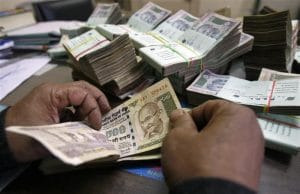






 Listen to the Article
Listen to the Article  Daily Newsletter
Daily Newsletter





